After an exciting season that was littered with brilliant goals, assists, and plays, the NWSL season came down to the final four teams for the 2019 Championship. For the second time in franchise history, the Red Stars host an NWSL semi-final match. The SeatGeek Stadium has been in the epicentre of the league earlier this season when the Red Stars defeated the North Carolina Courage in front of a record crowd of 17,388. The second of the two semi-finals to be played on Sunday were Chicago Red Stars vs Portland Thorns. The two teams experienced rollercoaster seasons with the Red Stars starting off well but dipped mid-season. Their resurgence in the final few game weeks saw them surge up the table into second.
Thorns were keeping pace with the leagues best for the first twenty games of the NWSL season, but a late dip in form dropped the side into third place in the table, sending the team on the road for a play-off semi-final for the first time during Mark Parsons’ tenure with the team.
This tactical analysis will look to analyse the tactics employed by both coaches and how they aimed to secure a berth in the final.
Squads & lineups
Rory Dames stuck with the same team that bested the Utah Royals in their final league game of the season. They continue with their faithful 4-2-3-1 formation that served them well over the season. Julie Ertz continued to partner Tierna Davidson in the heart of defence with Sarah Gorden and Casey Short flanking them. Arin Wright was out with illness having started the season strongly but injuries took a toll on her as the season wore on. The lethal pairing of Sam Kerr and Yuki Nagasato continued their partnership in attack looking to cause Portland Thorns defensive issues.
Alyssa Naeher has made 43 saves, conceding just 15 goals and six clean sheets this season and looked to continue her fine form. The Red Stars defence has been as critical as their offensive firepower and would need both to fire against a team that have got the better of them this season.
Parsons too looked to continue his winning formula by continuing his 3-4-1-2 formation. Tobin Heath and Canadian striker Christine Sinclair spearheaded the attack with Lindsey Horan and Dagný Brynjarsdóttir making up the midfield double pivot. Adrianna Franch has been equally impressive with 42 saves, conceding 20 goals leading to five clean sheets this season.
Chicago Red Stars (4-2-3-1): Naeher; Short, Ertz, Davidson, Gorden; Colaprico, Brian; DiBernardo, McCaskill, Nagasato; Kerr
Portland Thorns (3-4-1-2): Franch; Menges, Sonnett, Reynolds; Klingenberg, Horan, Brynjarsdóttir, Ball; Andressa; Heath, Sinclair
Chicago Red Stars quick movements
The Red Stars took the game to the Portland Thorns in the opening exchanges with the home side playing high-energy football. Quick passes and explosive movements from the Chicago midfielders ensured they caught Portland off guard early on. Part of Chicago’s tactics was to try and utilise Kerr’s pace through the creativity of Nagasato, DiBernardo, and McCaskill. The three attacking midfielders showed incredible movement and positioning early on to disrupt and disorganise the Portland backline.
We’ve seen Portland Thorns struggle to contain the wide areas in the past when using the three-at-the-back formation. The wing-backs tend to push high up and leave space in behind. It was evident against Utah Royals and Orlando Pride who both exploited spaces between the lines. Dames looked to follow a similar pattern and use the creativity of Nagasato to play in the likes of Kerr and DiBernardo. The gap between midfield and defence was too great as it allowed the Red Stars to freely move around and play in.
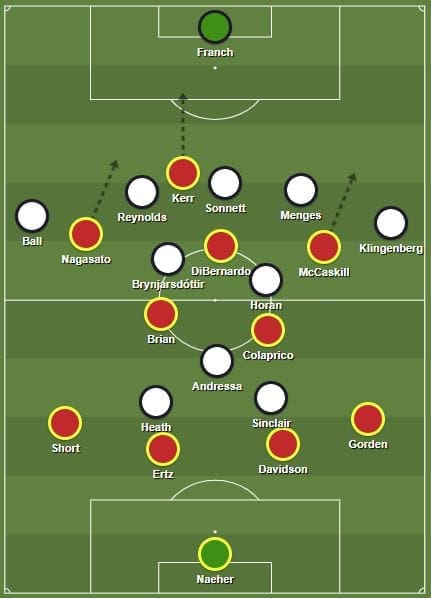
To better understand the Red Stars’ movement, we can analyse the above graphic to further elaborate on their shape and movement. As we can see here, the Red Stars attackers took up a narrow and deeper starting position and played close to the Thorns midfielders. Nagasato’s inward movement towards the penalty area takes the attention of centre-back Katherine Reynolds. This meant Kerr was left isolated with Emily Sonnett to create a one v one situation.
Emily Menges and Brynjarsdóttir needed to be wary of DiBernardo and McCaskill’s movements as they become extra supporting players in and around the penalty area. The deep positioning of Nagasato keeps Portland pushed up and with her innate skill of creating space, Kerr is able to find pockets of space to latch onto through balls from her attacking midfielders.
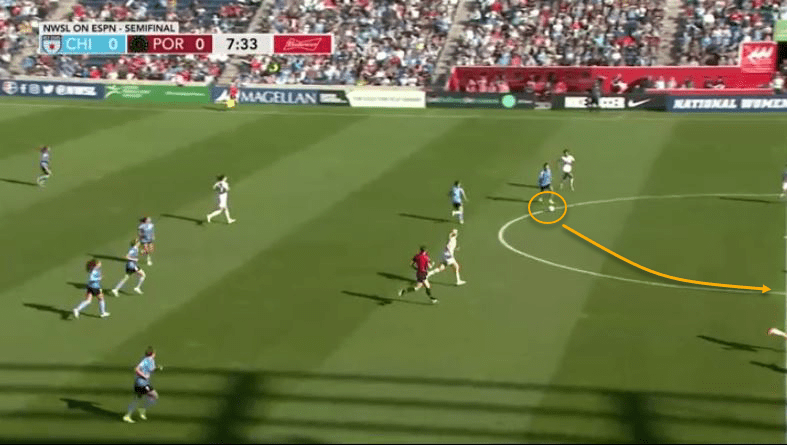
The early goal was a testament to her incredible skill. The first point to note is the abundance of space in midfield for Chicago to utilise. Nagasato has ample time to run and pick out her pass to Kerr. Chicago transitioned from back to front efficiently and effectively in the first half and reaped the rewards early on. McCaskill has space to make a free run on the near side unopposed, once again, reiterating the space the Red Stars had to play in.
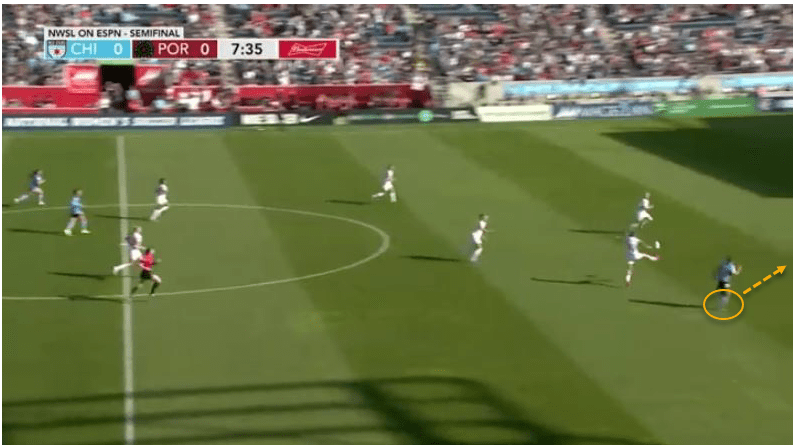
Kerr gambled on Nagasato’s long-ranged pass and it paid off as Sonnett mistimed her interception allowing Kerr to race through unopposed and slot the ball past Franch. While there are four defenders back for Portland, they weren’t organised courtesy of the Red Stars efficient, direct, and quick transition.
Space in behind the lines
The Red Stars ability to use the wide spaces as an attacking outlet was clear to see in the first half. While we saw them go through the central areas with Nagasato, Gorden showed promise with her forward runs. The right-back was seen pushing up time and time again, exploiting space in behind Klingenberg. Gorden was seen crossing from different angles with no real pressure.
Any time Portland received possession in the middle of the park, Chicago were able to quickly dispossess the ball carrier and send the ball out wide. This was mainly down to the Thorns inability to close down Chicago’s central midfielders. While the next section will further elaborate on their ineffective pressing, it seemed as though the Red Stars were able to control the Thorns’ movement.
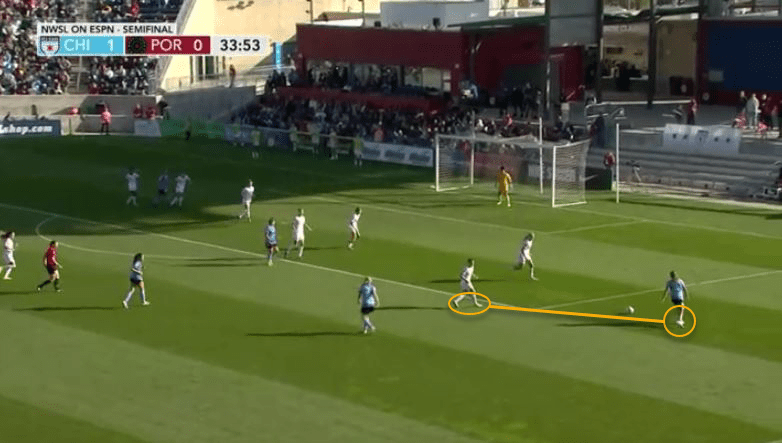
Parsons’ side use their wing-backs Elizabeth Ball and Klingenberg as crucial attacking outlets. Whether instructed to remain high or lacking the speed or positional awareness to get defend in defensive positions, they are too slow in transitioning to defence.
Ineffective pressing from Portland Thorns
The first half was littered with mistakes as Portland failed to assert any control over the game. They could have easily been two goals down if not for Franch’s saves. The key to winning a football match lies in winning the midfield battle and the Thorns failed to do exactly that. Horan and Brynjarsdóttir were not quick to press or close down their Chicago counterparts which allowed them free reign to control the tempo of the game.
What was surprising to see was the lack of communication between the Thorns. Both Sinclair and Heath pressed diligently from the front but the midfielders seemed to back off and allow Chicago to play freely in midfield. Any team employing a press heavy system requires every line to be in sync otherwise it becomes easy for the opposition to bypass it.
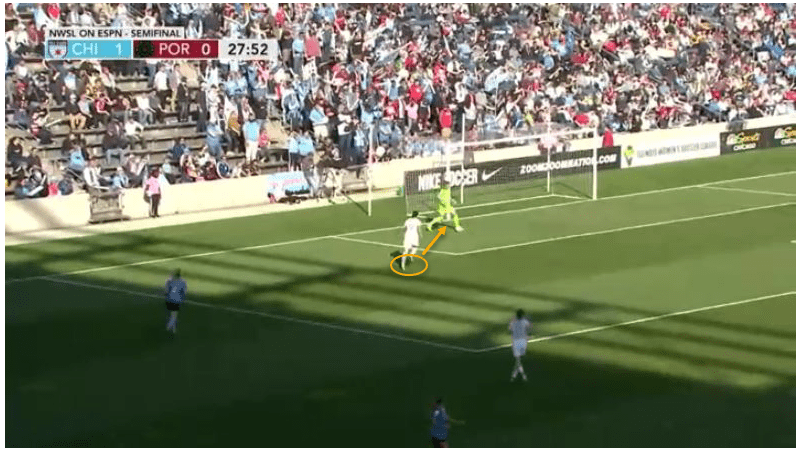
Horan, usually an explosive and powerful presence in midfield looked a shadow of herself in the first half, unable to hold on to possession and play in the dangerous front three. Horan is particularly devastating with her style of play suited to late surges into the box. Ideally, they would look to isolate players and create numerical superiority in the 18-yard area. Brian and Colaprico did well to stop her attacking forays and were able to distribute it out to their more attacking players without any real resistance. The second half saw a change in their approach and shape which allowed them much more possession and control; however, it wasn’t after a run around in the first half.
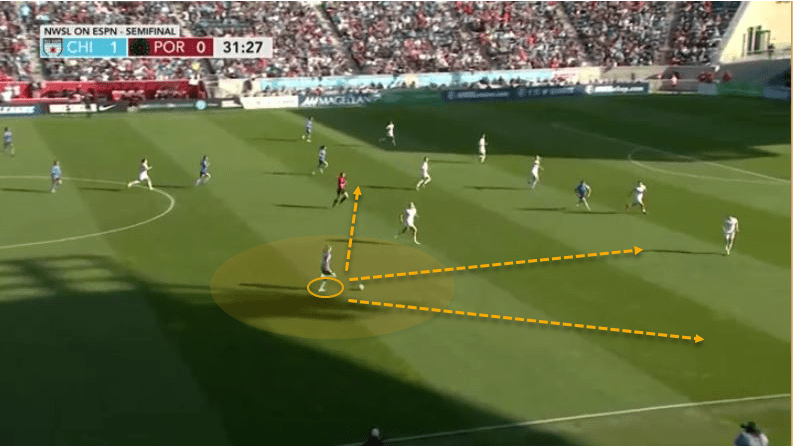
Most of the first half resembled the above graphic. Brian was able to run into Portland Thorns’ half unopposed and choose her pass. With no pressure on her, she is able to assess her options and chooses to pick out Gorden (out of frame) who is pushing forward from right-back. Portland did, however, fall back and hold a good defensive shape but the space in midfield allowed the Red Stars to dictate their movement. The off-the-ball runs by Chicago moved Portland’s players around and enabled the other Red Stars attackers time to attack.
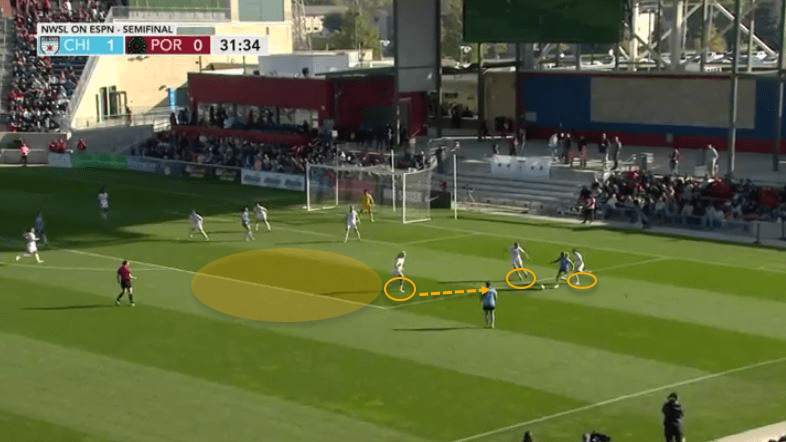
Here we can see Gorden’s run inside with the ball attract three players towards her position and create an opening in the Thorns 18-yard box.
Portland Thorns’ system change makes a difference
Portland Thorns needed to make some drastic changes at half-time to find a way back into this match. If they allowed Chicago the same room they afforded them in the first-half it would have been a matter of time before the Red Stars extended their lead. Parsons’ did, however; make a half-time substitution by taking off Ball and bringing on Hayley Raso. This also prompted a change in formation to a 4-2-3-1 matching Chicago.
The change in shape gave the Thorns a few advantages in the second half. First, it allowed the Thorns to get on the ball and control midfield through their Horan and Brynjarsdóttir. With Brian and Colaprico not being allowed the control from the first half, Naeher resorted to long balls into Kerr. The Thorns centre-backs won most aerial duels with their midfielders winning the second ball.
Secondly, and most importantly, Parsons wanted to take advantage of the Red Stars narrow defensive line. This is a tactical move that was used by Chicago throughout the season with the two full-backs tucking in to give them more solidarity through the central areas. Both Gorden and Short tucked in as the pressure mounted.
The introduction of Raso proved to be a masterstroke as they probed menacingly and caused the Red Stars defensive line some discomfort. It was Raso who caused Chicago the most problems in their last outing in August by beating Short repeatedly. Her substitution brought energy, pace, and movement in the wide areas finally giving Portland an attacking outlet. Another by-product of this tactical change was the focus moving away from the central midfielders. This allowed Horan to make her trademark runs that make her so dangerous.
The introduction of Margaret Purce later in the half gave the Thorns a speedy focal point and once again brought forward a change in positions for certain players. Sinclair operated in behind Purce with Heath and Raso flanking her. The idea was to create space through Purce’s pace and movement for the likes of Heath, Horan, and Sinclair.
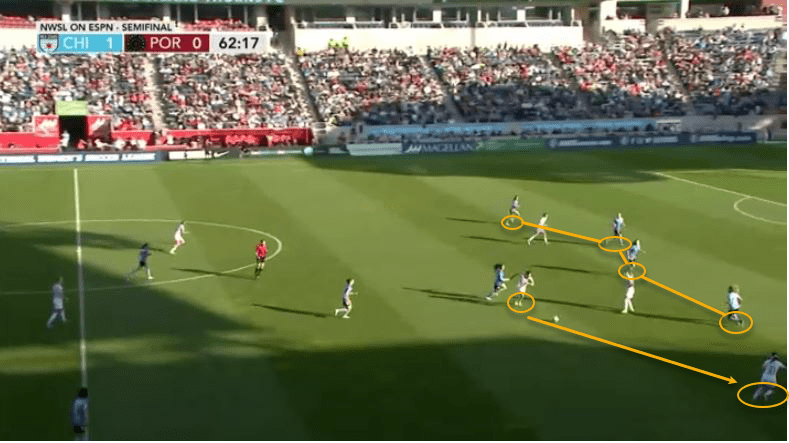
The above graphic is a clear example of Chicago’s narrow backline with an abundance of space in the wide areas. Raso has enough space to manoeuvre herself into a good position to attack the wide right space. Short, has to break from her three defenders to try and close down the winger but this has already allowed the Thorns to move into the final third.
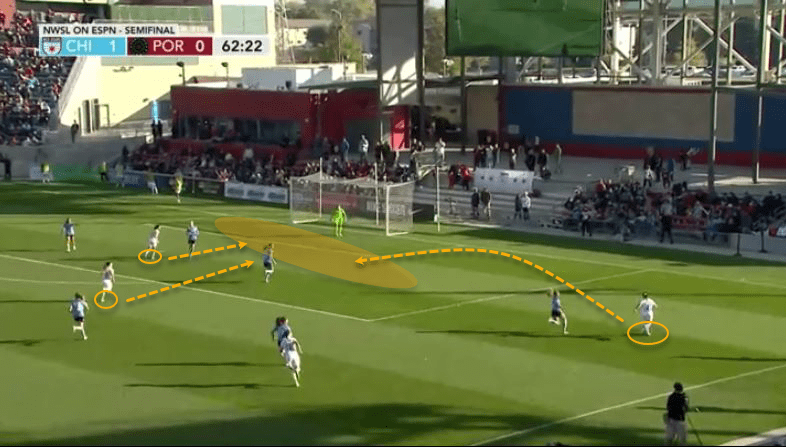
Notice the gap between Short and Davidson that can be easily exploited by a quick burst of pace from Raso and the onrushing Andressa. If the Brazilian attacker moves into the highlighted space, she will be able to receive Raso’s pass and create space for Sinclair, Heath, and Horan to drive into.
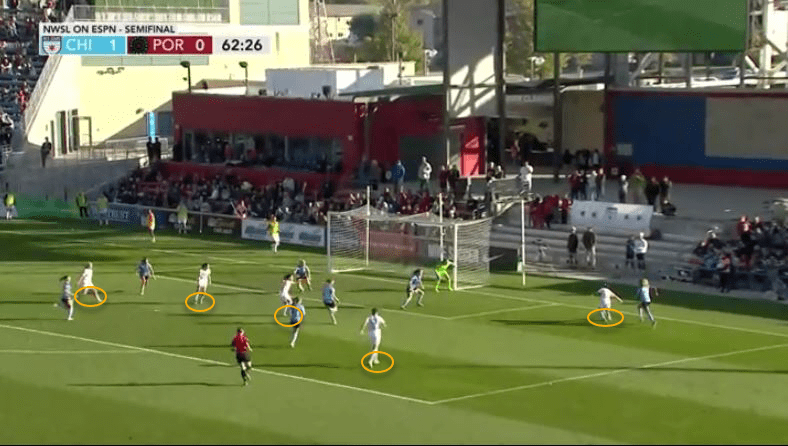
Chicago Red Stars‘ intent with the narrow backline was to stop Horan’s attacking forays and the intricate movements of Heath in the half-spaces. This requires solidarity, compactness, and discipline. This was a tactical move that was heavily exploited by the Thorns in their 3-0 win earlier in the season, however, they managed to keep it tight this time around. Those tactics were a mirror of their second-half changes here and they exposed the back line’s poor defensive display in August.
However, this time around the Red Stars held on and the key difference was the leadership and experience of Ertz in central defence. The American defensive midfielder marshalled her backline well and made a number of telling contributions to keep the Thorns at bay for 45 minutes.
Conclusion
This truly was a tale of two halves with both sides clearly winning 45 minutes each based on their performances. Ultimately, the Red Stars came out on top and for the first time in their club history made it to the NWSL Championship finals. After five appearances in the play-off semi-finals, they go through to face North Carolina Courage in what promises to be a hotly contested final. The analysis has shown that the Chicago Red Stars did improve their defensive strategy especially when the pressure was piled on by the Thorns. With the Red Stars likely to face two strikers against North Carolina Courage on Sunday, they will have to deal with a different threat but one they believe they can handle.

If you love tactical analysis, then you’ll love the digital magazines from totalfootballanalysis.com – a guaranteed 100+ pages of pure tactical analysis covering topics from the Premier League, Serie A, La Liga, Bundesliga and many, many more. Buy your copy of the October issue for just ₤4.99 here






Comments